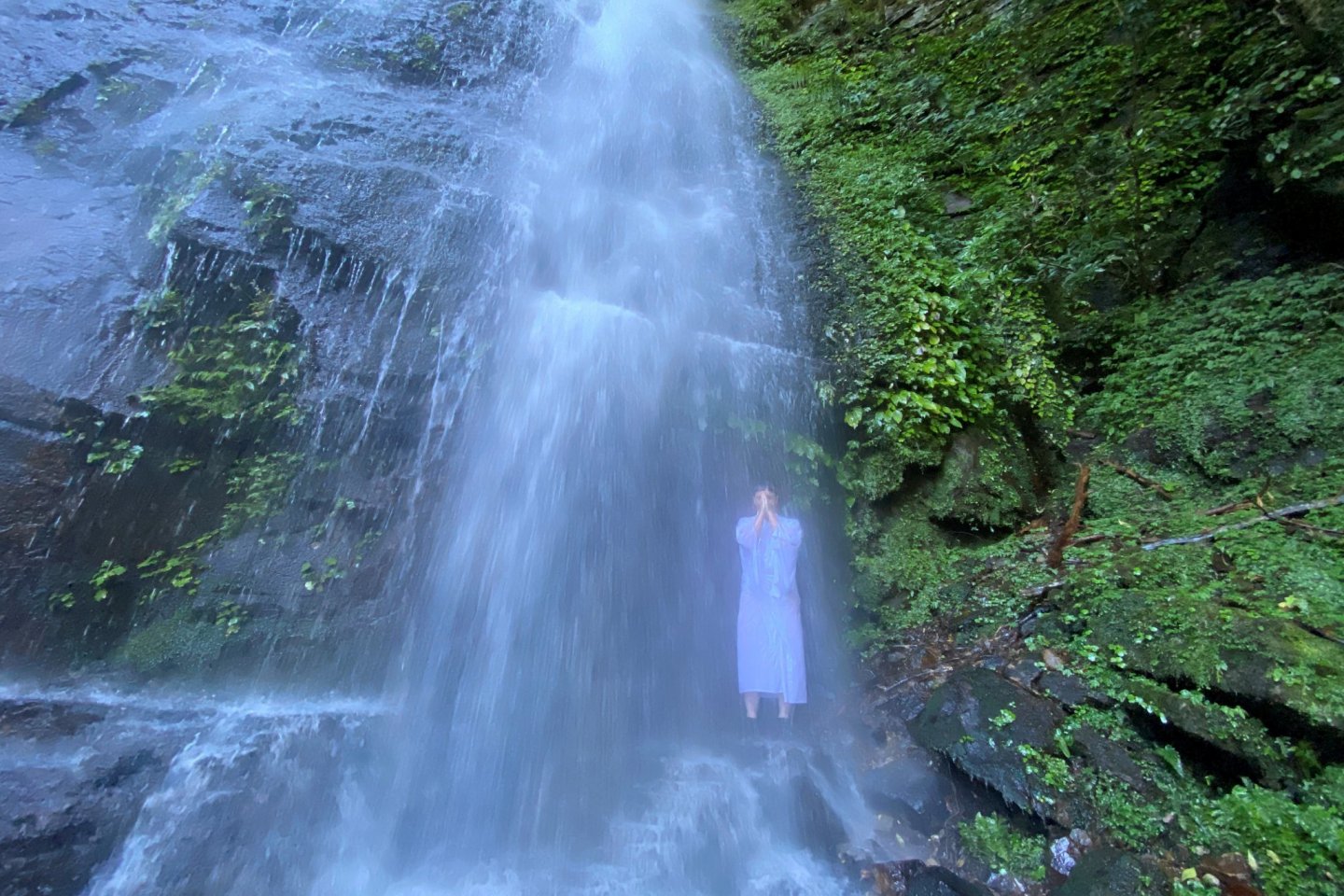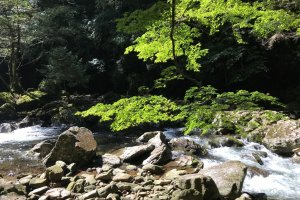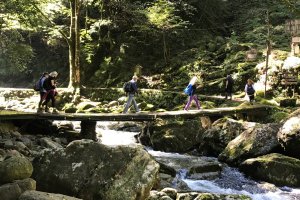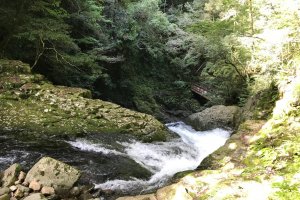Combining nature appreciation with spiritual experiences on your holiday is emerging as a post-Corona trend. Visitors to Japan who seek “nature & spirit” adventure travel are lucky as this country is in a unique position to have both a great natural environment and a rich spiritual tradition.
How about meditation in the Great Outdoors? If you want to add adventure, then meditate under a gushing waterfall?
Taking a meditation session at a temple has become a popular activity for visitors of Japan. Be it Zazen (seated Zen meditation) at a Zen Buddhist temple in Kyoto, or Aji-kan (seated meditation focusing on the Sanscrit letter A) at a Shingon Esoteric Buddhist temple on Koyasan, meditation classes have made it into the Japan itinerary of many foreign visitors.

Scenic landscape and endangered species
Did you know that the largest part (70%) of Japan are covered by mountains and forests? There are a great number of National Parks and Quasi-National Parks. The Muro-Akame-Aoyama Quasi-National Park, located in Kansai’s Mie and Nara Prefecture, is one of them. This Quasi-National Park was established in 1970 and it covers over 260 square kilometers.
This is where the Akame Gorge known for its many waterfalls is located. The official name is “Akame 48 Falls” and it is often stated that the number 48 just stands for many. Indeed, there are more than 48 falls in this park. However, there might be another explanation which has to do with a fiery Buddhist deity.
The Akame Gorge is home to the Giant Salamander. This amphibian was designated as a National Special Natural treasure in 1952. The Japan Salamander Center is housed in a building by the entrance of the trail leading into Akame Gorge.
Those who want to learn more about the Giant Salamander will find a lot of information here. There are also some aquariums that are home to salamanders of different species. Usually the Giant Salamander, now an endangered species, would live in the clear waters of the Taki River which flows through the gorge.
This gorge was created by volcanic activities millennia ago. Steep rock walls and large boulders dominate the landscape in the valley. However, the area is forested now and there are many momiji (Japanese maple) trees and urushi (Japanese lacquer) trees. Hence, the alley is popular in autumn because of the colorful maple leaves.


Once a Shugendo training place
Did you know that traditionally Japanese people combined Buddhism, Shintoism, Taoism and folk beliefs in a syncretic way? This is still now the case in Shugendo, an ascetic tradition based on mountain worship with ancient roots that is still practiced in Japan today.
The Akame Gorge was a sacred training ground for practitioners of Shugendo until the Meiji Period (1868-1912) when the Meiji Government tried to split Buddhism and Shintoism and also outlawed Shugendo. Followers of Shugendo went underground and discontinued any open practices. Their sacred training grounds in nature were opened to the public and became parks.
This also happened here at the Akame Gorge. After the Second World War Shugendo was rehabilitated and practicing was allowed again. However, by then the damage had been done and Akame to date is not an active Shugendo center anymore.
There is evidence of its Shugendo past in many place names. Some names of waterfalls, for example, referring to Buddhist deities, such as Dainichi Fall, Senju (Kannon) Fall and Fudo Fall, remained from that time.
Actually, one fall is even called Gyoja Fall. Gyoja is the name of a person (ja) who does ascetic training (gyo). Practitioners of Shugendo are referred to as Gyoja, but popularly they are known as Yamabushi.
One of their ascetic practices is takigyo, or waterfall (taki) training (gyo) and there are plenty of falls around. Another practice is a fire ceremony, or goma, and there is a place, namely the Goma Cave, were such rituals might have been conducted.


The walk to the Dainichi Fall
There are many options for how you can mediate in nature. Some ways are be calming and reflective while others are stimulating and invigorating. At Akame you are offered to join an eco-tour that consists of a hike to the Dainichi Waterfall and a waterfall meditation experience under this waterfall.
Don’t worry! The focus is not on hard Shugendo training but on nature experience. This is different from so-called “Yamabushi experiences” that are now also offered to curious tourists.
A guide welcomes you at the Eco Tour Desk in the Akame Visitor Center where you will receive a white kimono that is later worn under the waterfall. The waterfall meditation is conducted in the spirit of a purification activity. Those who step under a waterfall should wear all white, be them Shugendo practitioners or eco-tour participants.
You then walk along the paved trail that follows the river into the gorge and soon you will see the first waterfall. This is the Gyoja Fall. Maybe Shugendo practitioners in the old days would purify here before entering the sacred area that is said to have started beyond the Fudo Fall.
Other than Shugendo practitioners apparently nobody was allowed to move beyond this point. In fact, people might not have been able nor have dared as there was no path and no bridges until the Akame Gorge became a park. Nowadays it is made easy. The walk to the Fudo Fall takes less than 10 minutes from the entrance of the valley and walking to the base of the Dainichi Fall takes only 30 minutes.
The Dainichi Fall is named after Dainichi Nyorai, the Cosmic Buddha, which is the highest ranking deity in Esoteric Buddhism in Japan. The fall is located off trail and can only be reached by climbing over rocks following a small trail into a side valley. Depending on your level of fitness, it might take another 30 minutes to reach the fall. This short but steep climb might be challenging for some people, and it is also easy to lose one’s footing, but the reward is a spectacular waterfall view.
This walk follows the “short and easy course” that ends at another fall further into the valley. There is also a “moderate course” and an “advanced course” for more experienced hikers. The eco-tour, however, will not take you further along any of these courses but takes you back to the Visitor Center.
Your guide might urge you along as he is keen to get to the fall but nature lovers will be distracted at every curve of the trail. There are too many vistas to enjoy and too many opportunities to take yet another nature shot with your camera.


The highlight: waterfall mediation
Once you get to the base of the waterfall, the guide asks you to change into a white kimono. There is a small tent that can be used if you are shy to change in front of others. When all are glad in white, bare for the guide, he encourages you to take a few minutes and meditate sitting on a rock in front of the fall.
There is no further instruction but you might want to close your eyes and listen to the sound of the waterfall and feel its presence. Then people on the tour step under the fall, one by one. You might want to put your hands together in prayer before you step under the veil of water and again after you come out of it, in gratitude and veneration of the spirit of this fall.
Stepping under the gushing cold water without preparation might be a bit of a shock to the system. You could splash yourself with water first to get wet and feel the coldness of the stream, then step under the fall.
How long you stay there depends on you. For some people a minute is enough while others want to stay a little longer. This also depends on the season and on your frame of mind. If you consider this a spiritual experience, then why not say a prayer under the waterfall.
In the spiritual tradition of Shugendo, in Buddhism and in Shintoism, purification is important.
There is a ritual with a sequence of actions and prayers that are followed before, during and after the waterfall experience. In these traditions there is typically a guide who take participants through this ritual.
Here at Akame this waterfall experience is considered a mindfulness in nature practice. It is for everyone who wishes to experience stepping under a waterfall in a supervised fashion. There is no direct religious connection and no prescribed ritual to follow. This makes this experience easy to enter for folks from all sorts of backgrounds. It is perfect for those people who describe themselves as “spiritual but not religious”.
After everyone is finished, people change back into their hiking outfit and get ready for descending the trail from the waterfall to the main path that runs through the valley. The guide takes you back to the Visitor Center where the tour finishes.


A nature treat in all seasons
However, the Akame experience here is not finished for you yet because you can follow up with a hot water “purification” in a nearby onsen. The entrance fee to the onsen is included in your tour ticket.
Getting invigorated by the cold water of the waterfall and then relaxing in the hot water of the hot spring all in 2 hours is a wonderful experience. Being all too keen to get to the fall, and then eager to get to the hot tub might mean that you don’t really take in the wonderful scenery in this valley. At each bend of the trail nature presents you with ever changing arrangements of trees and rocks by the river. There are also some other waterfalls, some powerful and some gentle, that you pass by before you take the turn to the Dainichi Fall.
In spring the young green leaves of many maple trees are a beautiful sight. The scenery in summer is refreshing green and cool by the river. In autumn the colorful leaves of the maple trees are waiting for your visit. In winter Dainichi Fall gets frozen, which is a spectacular sight.
While a walk through the Akame Gorge is possible year-round, the waterfall meditation experience is only available from June 1 to October 31. So, coming here during the warm season is best!






































